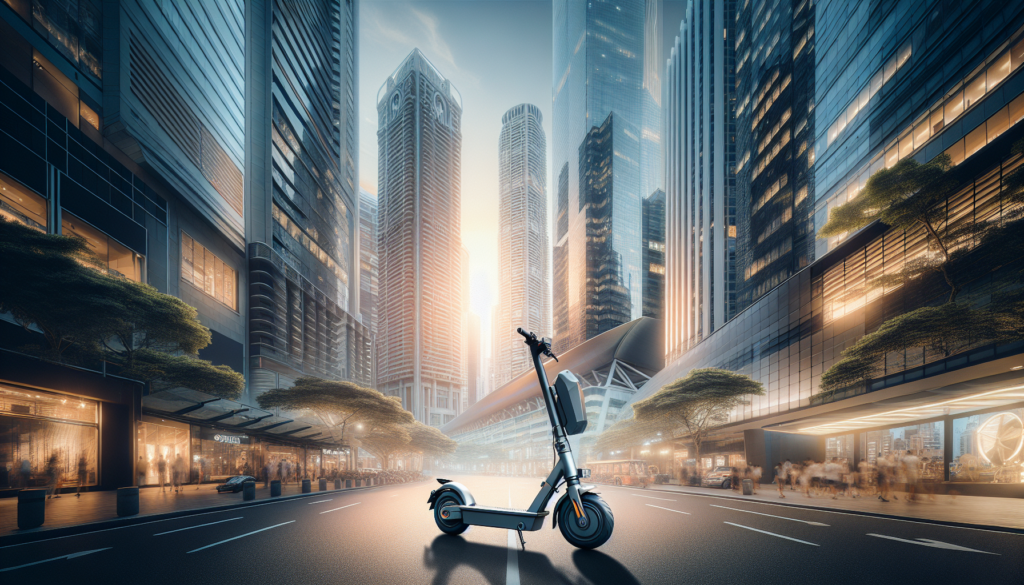
In the ever-evolving landscape of urban transportation, electric scooters have become a popular choice for commuters seeking convenience and efficiency. Two contenders in this arena are the Xiaomi Electric Scooter 3 and the Eko Life OEM Xiaomi Electric Scooter. Both models promise an enhanced commuting experience, but which one truly stands out for urban dwellers? With factors such as weight, battery capacity, range, warranty, and price all playing critical roles in the decision-making process, it’s essential to delve into a head-to-head comparison to determine which electric scooter reigns supreme in addressing the needs of the modern commuter.
Overview of Xiaomi Electric Scooters
In the world of electric scooters, the Xiaomi Electric Scooter 3 and the Eko Life OEM Xiaomi Electric Scooter stand out as two compelling choices for urban commuters. The Xiaomi Electric Scooter 3 weighs in at 13.2kg and comes equipped with a robust 36V 5.2AH battery, offering a range of 20-30km, making it a reliable option for short to medium commutes. Its price tag of RM 1,299 is reflective of its popular brand stature and features, although it only comes with a 6-month warranty. While it does offer an impressive build quality, the limited warranty may raise concerns for those looking for long-term reliability from their purchase.
On the other hand, the Eko Life OEM Xiaomi Electric Scooter provides a slightly lighter frame at 12kg and houses a superior 36V 6AH battery which allows for an extended range of 25-35km. Priced at RM 1,188, with a more favorable 1-year warranty, this model may appeal to budget-conscious riders looking for added assurance on their diverse urban travels. With both models showcasing commendable features, urban commuters must consider factors like weight, range, price, and warranty as they weigh their options in the electric scooters market.
Key Specifications Comparison
When comparing the key specifications of the Xiaomi Electric Scooter 3 and the Eko Life OEM Xiaomi Electric Scooter, the differences become quite evident. The Xiaomi Electric Scooter 3 weighs 13.2kg and is powered by a 36V 5.2AH battery, offering a range of 20-30km on a single charge. It comes with a 6-month warranty and is priced at RM 1,299. This model is well-suited for those looking for reliability and performance but may be slightly heavier for daily commuting.
On the other hand, the Eko Life OEM Xiaomi Electric Scooter is slightly lighter at 12kg and houses a more powerful 36V 6AH battery, which allows it to achieve a range of 25-35km. With a warranty of 1 year and a lower price tag of RM 1,188, this scooter presents a compelling option for urban commuters who prioritize value and range. While both scooters have similar battery voltages, the variations in battery capacity and weight could sway a commuter’s decision depending on their specific needs and preferences for urban navigation.
Weight and Portability
When it comes to urban commuting, the weight and portability of an electric scooter play a crucial role. The Xiaomi Electric Scooter 3 weighs 13.2 kg, which, while manageable for some, might be on the heavier side for those who frequently carry their scooter up stairs or onto public transport. Despite this, the scooter’s robust build quality and design provide a reliable ride. Its weight is counterbalanced by its sturdy construction, making it a firm favorite for those who prioritize durability.
On the other hand, the Eko Life OEM Xiaomi Electric Scooter boasts a lighter weight of 12 kg, making it slightly easier to maneuver and transport. This scooter strikes a balance between portability and performance, especially for urban commuters who may need to navigate crowded areas or hop on and off public transport. The lighter weight of the Eko Life model can be a significant advantage for daily commuters, offering greater ease when it comes to lifting and carrying. Both models present appealing options, but your choice will ultimately depend on how much you value portability in your daily urban commuting experience.
Battery Performance and Range
When considering electric scooters for urban commuting, battery performance and range are crucial factors that can significantly impact the rider’s experience. The Xiaomi Electric Scooter 3 features a 36V 5.2AH battery, providing a range of 20-30 kilometers per charge. While this range is suitable for short commutes, it may fall short for those who require a longer distance coverage for daily travel.
On the other hand, the Eko Life OEM Xiaomi Electric scooter boasts a slightly more powerful 36V 6AH battery, allowing it to reach an impressive range of 25-35 kilometers. This additional battery capacity can be a game-changer for urban commuters who want the peace of mind that comes with extra distance to spare during their rides, especially in bustling city environments where distances can be unpredictable. The ability to rely on a scooter’s battery performance not only enhances convenience but also contributes to a rider’s overall confidence on the road.
As urban commuting increases in popularity, having a scooter with superior range becomes increasingly important. While both models are reliable, the Eko Life OEM’s extended range can prove more beneficial for those commuting across longer stretches or navigating through unpredictable urban traffic. Therefore, for commuters prioritizing battery life and range, the Eko Life OEM Xiaomi Electric scooter comes out on top in this showdown, providing a more satisfactory and stress-free riding experience.
Warranty and After-Sales Service

When choosing between the Xiaomi Electric Scooter 3 and the Eko Life OEM Xiaomi Electric Scooter, the warranty and after-sales service play a significant role in the decision-making process for urban commuters. The Xiaomi Electric Scooter 3 comes with a 6-month warranty, which offers a decent level of coverage for any manufacturing defects or issues that may arise within the initial usage period. However, given the fast-paced nature of city travel and the wear and tear associated with it, a shorter warranty period might raise some concerns for potential buyers.
On the other hand, the Eko Life OEM Xiaomi Electric Scooter stands out with its 1-year warranty, providing greater assurance to users regarding the durability and reliability of their purchase. This extended coverage can alleviate the worries of urban commuters, who may face unpredictable commuting conditions and mileage demands. Furthermore, robust after-sales service is crucial for both models, ensuring that customers can access support, repairs, or replacements efficiently.
While the Xiaomi brand is well-known for its customer service, the OEM model’s longer warranty might reflect a commitment to higher customer satisfaction. This aspect could sway a commuter towards the Eko Life option, knowing that they have additional time to seek assistance if needed. Ultimately, weighing the warranty and after-sales support against each scooter’s features can help urban commuters make an informed decision about which electric scooter best suits their needs.
Price Analysis and Value for Money
When considering the price and value for money of the Xiaomi Electric Scooter 3 and the Eko Life OEM Xiaomi Electric Scooter, it’s essential to look at their specifications alongside their costs. The Xiaomi Electric Scooter 3 is priced at RM 1,299 and offers a solid build with a weight of 13.2kg, a 36V 5.2AH battery, and a range of 20-30km. While it may be on the higher end of the price spectrum, its reputation for quality and robust features makes it a reliable choice for urban commuting. Additionally, it comes with a 6-month warranty, which could be seen as a lesser commitment compared to its OEM counterpart.
On the other hand, the Eko Life OEM Xiaomi Electric Scooter is a more budget-friendly option at RM 1,188. This model weighs slightly less at 12kg, features a 36V 6AH battery, and boasts a longer range of 25-35km. With a one-year warranty, it presents an attractive argument for value-seeking consumers. Therefore, for those who prioritize not just the upfront cost but also the scope of performance and warranty duration, the Eko Life OEM model might provide better overall value for urban commuters looking to navigate city streets effectively while keeping budget constraints in mind.
User Reviews and Real-World Performance
When evaluating the Xiaomi Electric Scooter 3 and the Eko Life OEM Xiaomi, user reviews play a crucial role in assessing real-world performance. Many users of the Xiaomi Electric Scooter 3 highlight its robust build quality and overall performance, emphasizing the extra stability provided by its weight of 13.2kg. Cyclists also praise its impressive range of 20-30km, making it a reliable choice for urban commuters looking to navigate their city efficiently. However, some have noted that while it excels at short commutes, the battery life under heavier loads could be a limiting factor if you travel longer distances or frequently ride uphill.
Conversely, the Eko Life OEM Xiaomi has earned positive reviews for being lighter at 12kg and offering an extended range of 25-35km. Users appreciate the 1-year warranty, providing peace of mind that isn’t available with the Xiaomi Electric Scooter 3’s shorter warranty. Commuters have remarked on its flexibility and ease of use, especially over longer distances, making it a strong contender for those who frequently tackle daily rides. Ultimately, the choice lies with what the commuter values more: the sturdiness and reliability of the Xiaomi Electric Scooter 3 or the lighter, longer-range capabilities of the Eko Life OEM variant.
Conclusion: Making the Right Choice for Urban Commute
In conclusion, choosing between the Xiaomi Electric Scooter 3 and the Eko Life OEM Xiaomi model hinges on individual priorities and commuting needs. The Xiaomi Electric Scooter 3 boasts a slightly heavier weight of 13.2kg, which may be a consideration for those who frequently carry their scooter. It features a robust battery offering a range of 20-30km, making it a reliable option for shorter urban commutes. With a price tag of RM 1,299 and a 6-month warranty, it aligns well with those willing to invest a bit more for a well-established brand.
Alternatively, the Eko Life OEM Xiaomi is a lightweight choice at just 12kg, providing a more extended range of 25-35km from its 36V 6AH battery. Priced at RM 1,188 and backed by a 1-year warranty, it offers terrific value if you prefer a scooter with a longer lifespan for commuting purposes. Ultimately, urban commuters should weigh their specific requirements against each model’s features to determine which electric scooter best fits their lifestyle and budget.
Final Thoughts: Choosing Your Ideal Urban Commuter Electric Scooter

When it comes to urban commuting, both the Xiaomi Electric Scooter 3 and the Eko Life OEM Xiaomi present compelling features that cater to different needs. The Xiaomi Electric Scooter 3, with its robust build and slightly heavier weight of 13.2kg, offers a shorter range but comes with a solid 6-month warranty, making it a reliable choice for those who value brand assurance. For an enhanced battery capacity and longer range, the Eko Life OEM model stands out as an appealing option at just RM 1,188, combined with its 1-year warranty. Given its lighter weight of 12kg and slightly better performance, it becomes a preferable option for many urban dwellers looking for that balance between cost and capability.
Ultimately, the decision on which electric scooter to choose hinges on individual commuting needs and preferences. If you’re looking for longer trips with better battery specifications, the Eko Life OEM Xiaomi Scooter is an excellent choice. However, if a shorter commute aligns with your lifestyle, the Xiaomi Electric Scooter 3 delivers reliability and sturdy craftsmanship. Whichever model you choose, both scooters promise to elevate your urban commuting experience, offering convenience and eco-friendliness on every ride.

The value for money aspect is crucial in this showdown. Considering the warranty and battery performance, the Eko Life OEM Xiaomi model is a clear winner in my books. Its price tag might be off-putting at first glance, but it’s completely worth it.
We’re glad you appreciated the value for money aspect of our Eko Life OEM Xiaomi model. The 1-year warranty and superior battery performance make it a worthwhile investment. We understand that the price may seem steep at first, but as you’ve mentioned, it’s worth it for the quality and dependability you’ll get. If you have any further questions or would like to learn more about our products, please feel free to reach out to us at [email protected] or +60 3-7890 3042.
What caught my eye was the 1-year warranty offered by the Eko Life OEM Xiaomi model. I’d have to put this scooter on the wishlist, given I don’t have to worry about replacing broken parts anytime soon.
Thank you for bringing up the 1-year warranty of the Eko Life OEM Xiaomi model, Akash. We’re glad to hear that this feature caught your eye! At Eko Life Malaysia, we prioritize the satisfaction and peace of mind of our customers, and our warranty is just one of the ways we ensure that our products stand the test of time. If you have any questions about our warranty or any of our products, please don’t hesitate to reach out to us at [email protected] or give us a call at +60 3-7890 3042. We’d be happy to help.
I’m glad this Xiaomi Electric Scooter Showdown 2025 review highlighted the key differences between the two models. The weight of the scooter shouldn’t be underrated, especially for daily commutes.
Thank you for sharing your thoughts on the review, Sherlyn! You bring up a great point about the weight of the scooter being an important consideration for daily commutes. At Eko Life Malaysia, we design our products with mobility and convenience in mind. If you have any questions or concerns about our OEM Xiaomi model, feel free to reach out to us at [email protected] or +60 3-7890 3042. We’d be happy to help.